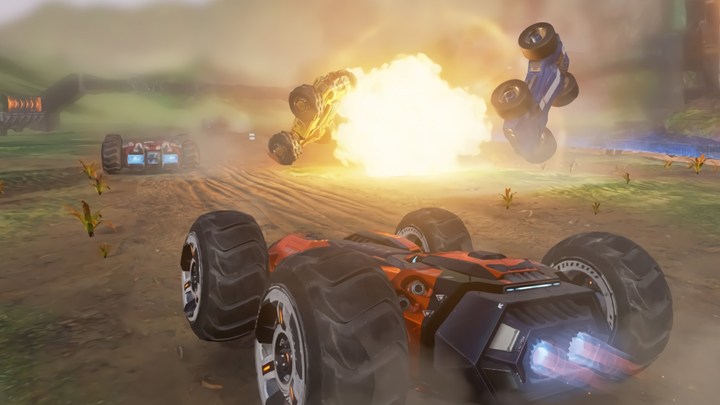Start your engines, audience, and get a GRIP; for that is the game being reviewed today, coming courtesy of Caged Element, who made this video possible by supplying a review code. So, without further delay, it’s time to burn rubber and drive into the world on display.
Now’s the point where I talk about the game’s story…wait, no story? What do you mean no story? Seriously, playing racing games for the story? Nah. Not even needed. What you’re here for is the racing, so let’s get to that.
GRIP is a combat racing game. Right off the bat, a certain demographic of players should recognize GRIP for what it is immediately; in the same vein of Yooka-Laylee being a reskinned Banjo-Kazooie, GRIP is a reskinned Rollcage. And you might be asking, what is Rollcage? An old duology of racing games that can be best described as F-Zero meets Twisted Metal with a wacky physics engine. In other words, a high-speed racing game with a large emphasis on vehicular combat, with physics that are analogous to Rocket League, for the sake of a recognizable comparison. These elements are what made Rollcage and now GRIP stand out amongst their racing brethren, and there aren’t many, if any games like it nowadays.
Moving on from the history lesson, GRIP, perhaps even more so than Yooka-Laylee, is much closer to its spiritual predecessor without changing much. In short, there’s big, open track design, crazy physics which can throw you off balance at a moment’s notice, a wide selection of powerups to cause even more chaos, and of course, lots and lots of speed. Chaotic would be a fitting one-word descriptor for the game. The speed levels are chaotic. The powerups create a chaotic environment. The track design and physics make for chaotic driving. Now, whether this is a good or bad thing is up to the player, but it’s a relatively safe assumption that anyone more accustomed to the relatively normal speed of something like Mario Kart may be disoriented by GRIP’s take on racing.
Granted, though, GRIP does have its ways to alleviate frustration. Depending on the mode, engine speed can be set to low or high. In races proper, if you’re sent flying for whatever reason, there’s a reset button which puts you back on track to catch up. The controls are tight and functional (though some placements are a bit awkward for vital functions like the secondary boost), even if they take some getting used to in conjunction with the physics.
GRIP’s unorthodox approach to racing by modern standards might be its most notable downside gameplay-wise. It’s fun, especially alongside friends to share the chaos with. But it’s not so easily accessible. It’s a game that requires you to think fast, react faster, and get used to things like the car physics; at the speed you’re going normally, it’s easy to hit even a small piece of terrain and be sent flying, most likely off track or in a position that kills momentum. That can make gameplay frustrating to some, though your mileage may vary.
Anyway, apart from racing, GRIP has enough to keep you occupied for a while. Time trials and battle modes are there, as are races with powerups and a campaign mode, which is mostly just racing on different tracks with different rules on a steadily increasing difficulty level; and the higher tiered races can get brutal. GRIP’s most curious game mode, another throwback to Rollcage, is the carkour mode; as the portmanteau implies, it’s a series of maps designed around reaching the goal in specifically designed maps, using anything from precise platforming to high enough speed. Some are easy, some are real difficult, and it’ll eat up time not spent doing races regardless.
GRIP aimed to do one thing gameplay-wise; a near 1:1 version of the duology which it’s based on. A faithful recreation, even if some of it could have used refinement; which, incidentally, is also a complaint thrown at Yooka-Laylee.
Another distinguishing aspect of GRIP compared to other racers is its edgier look. No bright, varied colors and landscapes, most of the presentation is dark, edgy and darkly edgy. Not to a ludicrous degree, mind you, but it does make the visuals kinda boring, especially when you don’t really have time to focus on matters that aren’t winning the races. The music is also not as engaging as the selection from the two Rollcage titles which inspired it as well, so GRIP has weak (but far from awful) presentation overall.
A notable criticism of the Switch port judging by other reviews was middling performance. Given its been over a week since the game’s release at the time of this review, the game has probably been patched at least once since then. Performance in both docked and portable mode has been stable, with a lower framerate of 30 fps to compensate, a trait common in Switch ports. This does make it pale in front of the Switch’s crown jewel of racing in the form of Mario Kart 8 Deluxe, but it’s still entirely playable.
GRIP is defined mostly by being a throwback to a 90s cult classic. On that note, it succeeds, as the transition is faithful. But nearly 20 years after the original Rollcage games, some added modernization would have helped GRIP a lot. To be fair, it’s still playable and distinct enough from other racing games available in the eShop library, so racing enthusiasts can find something new to enjoy, but GRIP can be a tough sell otherwise. Recommended to fans of high speed racing, combat focused racing, and those with the ability to do local multiplayer, unarguably the game’s strongest asset.









